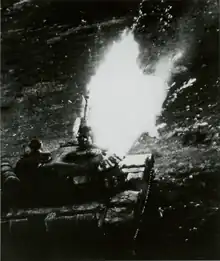OP-2 (ОП-2), or Ionov's salt, indicated on the package as Н. А., is a chemical substance used as a thickener.[1][2] The main component of OP-2 gel is gasoline. On the cardboard or cardboard packaging of the OP-2, the inscription "H.A." refers to its unit component, aluminum naphthenate. Due to the same orders as the initials of its name, OP-2 was, for a long time, interpreted as being the opalm, a "hybrid" swiss thickener.[3]
Effect
Contact with the lit material causes deep burns, due to the retarding effect of the thickener on the fuel and due to the greater thermal conduction given by the salt. It is an incendiary agent with anti-personnel and limited anti-material effect. It is used as a defoliant to deprive enemy personnel of cover and camouflage.[4]
Use

The use of the OP-2 is identical to that of napalm, being used extensively by any projector of incendiary material. The employment concentration is identical to that of napalm.[5]
Precursor used to obtain incendiary weapons, it is the standard flame fuel thickener of the soviet union.[6] It was first employed by the soviet union during the early part of world war II to prepare flamethrower fuel[7] (ROKS-3 and LPO-50),[8][9] molotov cocktail,[10] general incendiary weaponry.[11] It continues to be employed by the Russian army. For example, it is used to prepare the AP-10, which fills the ZB-500 incendiary shell.[4] The OP-2 was supplied to states aligned with the soviet union.[6][12]
Composition
The principle of a viscous incendiary weapon was first realized in the early Middle Ages in the form of Greek fire. In modern times, the first tests were carried out during the first world war in the form of solidified oil (SO), developed by CWS.[13] Gasoline and rubber mixtures were tested post-war and during the early stages of WWII. Rubber shortages, caused by the territorial expansion of imperial Japan, forced it to be replaced by synthetic materials.
During the early stages of the WWII, A. P. Ionov and Piotr Alexandrovich Rehbinder, in 1938-1940, specialized aluminum naphthenate to be inserted into fuels in order to thicken them.[14]
After Pearl Harbor, the CWS began hiring personal to investigate a natural rubber substitute in the US. The end result of the investigation was an aluminum soap that specialized in thickening fine fuels.[15]
OP-2 is an aluminum salt of petroleum acid derivatives. The OP-2 and gasoline solution behaves like an unconventional fluid. Its non-stoichiometric formula is (RCOO)1.5Al(OH)1.5.[16]
Preparation
OP-2 is prepared under specifications, these are relatively less closed than napalm.[17] Due the use of naphthenic acid as the unitary component, the reaction conditions are closed. Ionov investigated a series of thickeners based on naphthenic acid. The thickener obtained a satisfactory degree of thickening and stability when it was precipitated into a strongly alkaline aqueous medium.
OP-2 is prepared under a caustic excess of 100% to prevent sintering of the amorphous solid and undesirable chemical reactions. The general chemical reaction equation can be given as:[17]
See also
References
- ↑ "Дымовые и огнеметно–зажигательные средства". rufort.info. Retrieved 2022-10-10.
- ↑ Зажигательные средства дыма и огнеметы. А. Белоусов. pp 174-176.
- ↑ Bochsler, Regula (28 January 2023). "Napalm from the Alps: How the Swiss developed a lethal incendiary agent". SWI swissinfo.ch. Retrieved 2023-01-28.
- 1 2 "ЗБ-500". www.airwar.ru. Retrieved 2022-10-10.
- ↑ Федосеев, Семен; Ардашев, Алексей (2022-04-16). Огнеметные танки и ручные огнеметы в бою (in Russian). Litres. ISBN 978-5-457-58982-7.
- 1 2 ARMY. August 1968, 58-59
- ↑ Lakin G. Sherril. (U) NVA TRAINING AND EMPLOYMENT OF FLAMETHROWERS. Report No. 6 029 0019 70. Jan 1970
- ↑ "Огнем, водой и деревянными пулями: испытания советской винтовки-огнемета". kalashnikov.media (in Russian). Retrieved 2022-10-10.
- ↑ SupR 66152. Section XIII - Flamethrower, Portable, LPO-50. 223
- ↑ Tov_sergeantwrote, Tov_sergeant Tov_sergeant. "ПРО КОКТЕЙЛЬ МОЛОТОВА". tov-sergeant.livejournal.com. Retrieved 2022-10-10.
- ↑ Михаил Барятинский. Т-54 и Т-55. «Танк-солдат»: TO-54
- ↑ Captain James T. Parks. PORTABLE FLAME THROWER UNITS ORGANIC TO THE INFANTRY BRIGADE - ANNEX 3: The Portable Flame Thrower Use Against the American in Viet Nam by the North Vietnamese and the Viet Cong. Roster Number 121, Advisor Group 7, Advance 4. 25 September 1968
- ↑ AMOS A. FRIES and CLARENCE J. WEST. CHEMICAL WARFARE.New York: McGraw-Hill, 1921.
- ↑ Soviet Work on Solidified Fuels: B. I. Losev; Solid Gasoline. Priroda, Vol 47, No 9.
- ↑ "Napalm, An American Biography". Napalm, An American Biography. Retrieved 2022-10-28.
- ↑ Корольченко А.Я., Корольченко Д.А. Пожаровзрывоопасность веществ и материалов и средства их тушения. Справочник в 2-х томах (in Russian).
- 1 2 Корольченко А.Я., Корольченко Д.А. Пожаровзрывоопасность веществ и материалов и средства их тушения. Справочник в 2-х томах (in Russian).
Works cited
- A, N, Ardashev. (2009). Зажигательное и огнеметное оружие. ISBN 978-5-699-33627-2
- Управление Начальника Химических Войск Сухопутных Войск Вооруженных Сил Ссср. Ранцевый огнемет РОКС-3 (1946) - Материальная Часть И Курс Огнеметания. ПОСОБИЕ ДЛЯ ОФИЦЕРСКОГО СОСТАВА. Moscow -1946.
External links
PAKISTAN: LEADER OF REBEL AFGHAN GROUP CLAIMS SOVIET TROOPS HAVE STRAFED VILLAGES AND DROPPED NAPALM BOMBS. (1980) (Film). Pathé News. 1980. VLVA4EBU0SGGUZ73ZAVPS88EW95S9.